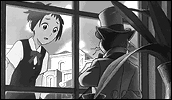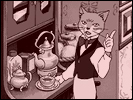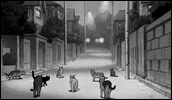The Cat Returns
- Year
- 2002
- Original title
- Neko no Ongaeshi
- Japanese title
- 猫の恩返し
- Director
- Cast
- Running time
- 75 minutes
- Published
- 13 August 2002



by Jasper Sharp
Funny, but the latest from Studio Ghibli seems to have slipped into the theatres with far less of the usual fanfare than one would expect from a new release from what must be currently the world's most avidly talked about animation house. Its appearance in Japan was vastly overshadowed by the mass pre-release hype which has surrounded the concurrent DVD release of Hayao Miyazaki's box-office busting, Golden Bear winning Spirited Away.
With Miyazaki now almost a household name on the world circuit, perhaps the powers-that-be have decided that there's little interest in the work of the Studio's other talents, especially given the lacklustre reception with which the last Ghibli product to go out without the endorsement of Miyazaki's name on it, Isao Takahata's My Neighbours the Yamadas (Tonari no Yamada-kun) was greeted in 1999. In fact, it is Miyazaki, acting in the role of Executive Producer, who receives the most significant credit on the posters for this new project. His name dwarfs that of its relatively unknown director, Hiroyuki Morita, whose sole directorial credit prior to this film is for the 1999 non-Ghibli feature taken from the long-running Tenchi Muyo anime series, Tenchi Muyo 2: Haruka naru Omoi, and whose previous credentials at the studio amount to working as an animator on a couple of earlier titles such as Kiki's Delivery Service (1992).
A sort of unofficial sequel to Yoshifumi Kondo's Whisper of the Heart, the first and hitherto last film to be directed by someone other than Ghibli's two main men Miyazaki and Takahata (not including the 1993 made-for-TV feature Umi ga Kikoeru a.k.a. Ocean Waves a.k.a. I Can Hear the Sea, directed by Tomomi Mochizuki), The Cat Returns owes little to its predecessor other than that it is based on a manga, Baron - Neko no Danshaku, by the same artist, Aoi Hiragi, which brings back a couple of incidental characters, most notably the Baron whose statue acted as the catalyst for Shizuku's ardent soul-searching in the earlier film.
In this latest, again, we have a young schoolgirl protagonist, Haru, pitched into a fantastical world after crossing paths with a nonchalant moggy, which in this instance she scoops up from the path of an oncoming truck, breaking her lacrosse stick in the process. Haru is flabbergasted when unfazed feline, whom it transpires is none other than an eligible young prince from an alternate world of the Kingdom of the Cats, subsequently gets up, dusts himself down and begins thanking her for saving his life. The local cat community is similarly appreciative of her gesture, leading a ceremonial procession up to serenade her on her front doorstep that same evening and depositing a pile of lacrosse sticks in the school corridor to make up for the broken one.
However, the cats' final act of gratitude, a degree of marriage offered by none other than the King of Cats to his son whose life she has just saved is met with a little less enthusiasm. An escape route presents itself in the form of the reappearance of a young white feline Haru first came across years before, and fed while she was starving to death. This cat turns out to be engaged to the young cat prince, and has no wish to see Haru married off to her betrothed. Instead she instructs Haru to follow a chubby white tom named Muta (memorable for his non-speaking yet pivotal role in the earlier film) who leads her to the Cat Office, staffed by the ubiquitous Baron. From then on it is up to the Baron to assist Haru in freeing herself from this binding cross-species marital agreement in an adventure that will lead her right into the heart of the Kingdom of the Cats and head-to-head against its mangy monarch.
The Cat Returns is a far safer film than Ghibli's more recent offerings, lacking both the epic flights of fantasy that mark out the work Miyazaki (Princess Mononoke and Porco Rosso) and the rigorous approach to character and plot of Takahata's finer films (Pompoko, Grave of the Fireflies and Only Yesterday). Notably short at only 75 minutes, and more obviously pitched at the younger end of the market, it still retains the dazzlingly drawn action sequences and touching humanism that we've come to expect from the Studios within a tighter, though overall less ambitious narrative that will leave few disappointed but will ultimately probably do little to win any new converts to Ghibli's work. As such, whilst entertaining enough in its own right, The Cat Returns can really be seen as marking time for the studio whilst Miyazaki decides whether he's going to retire or not.
The Cat Returns was accompanied into Japanese cinemas by the 25-minute short The Giblies - Episode 2 (Episode 1 aired on Japanese TV in 2000), a series of skits surrounding the characters of a fictitious animation studio, not all too surprisingly named "Ghibli" (though pronounced "gi bu ri", with a hard "G" to distinguish it from the real Studios, which is pronounced using a soft "J"), rendered in a variety of styles testifying to the talent and imagination by the forces at work behind the scenes there which range from the surreal, as in the opening tale of a curry eating competition at a local eatery, through the humorous, in a vignette of the commonplace commuter train phenomena of a pretty young girl falling asleep on the shoulder of the person sitting next to her, to the touching reminiscences of young love forged between two of the characters at an elementary school art exhibition. This short, and I mean this as no disservice to the feature which it supports, is worthy of the ticket price alone, and when taken together, the two films form as satisfying an evening of entertainment as you're likely to get anywhere.